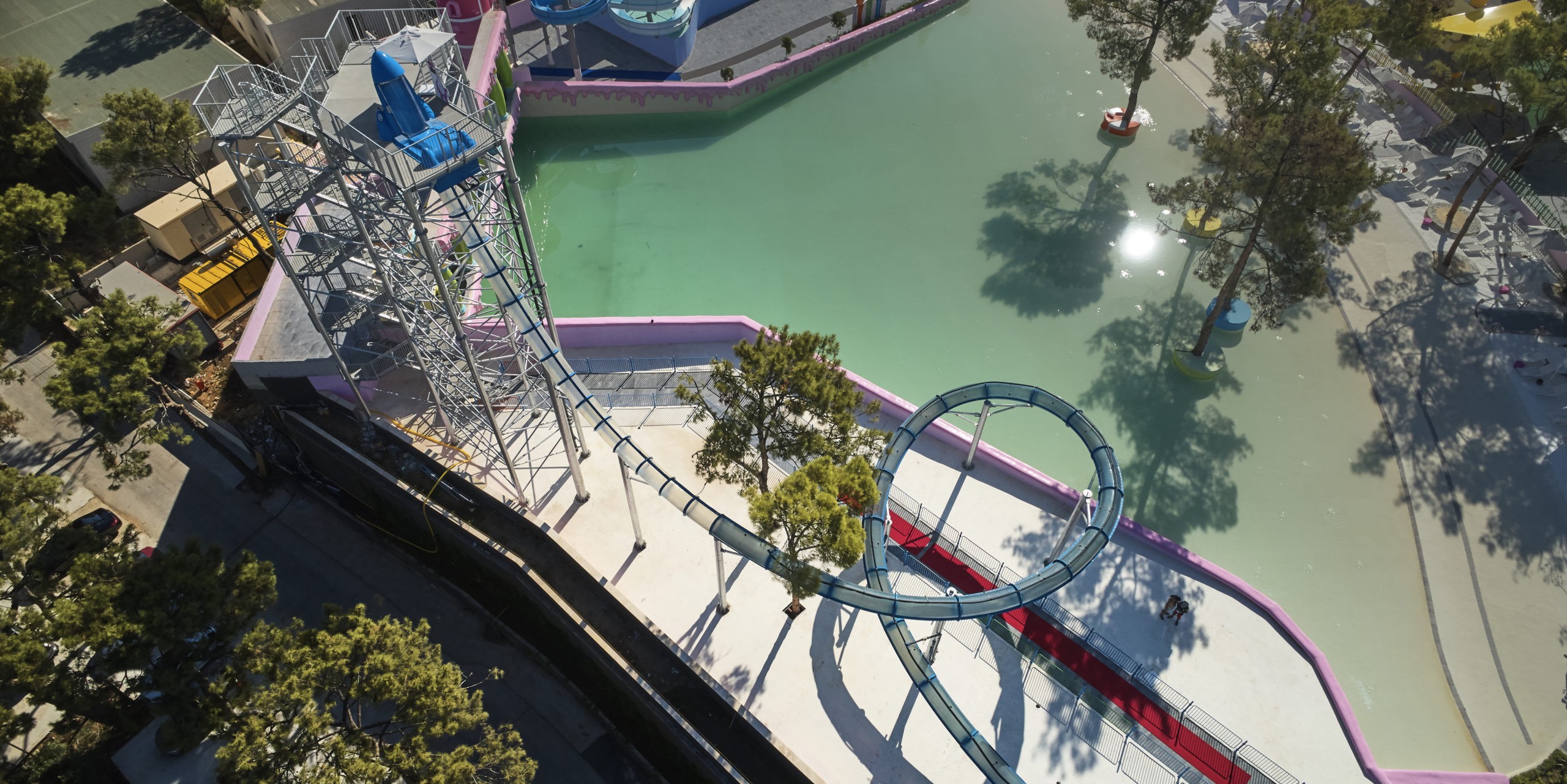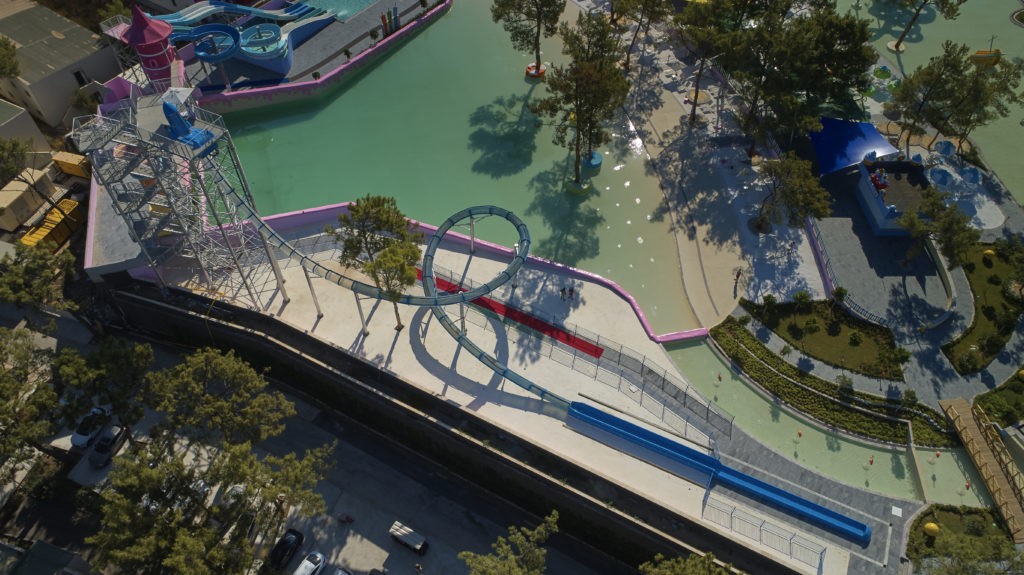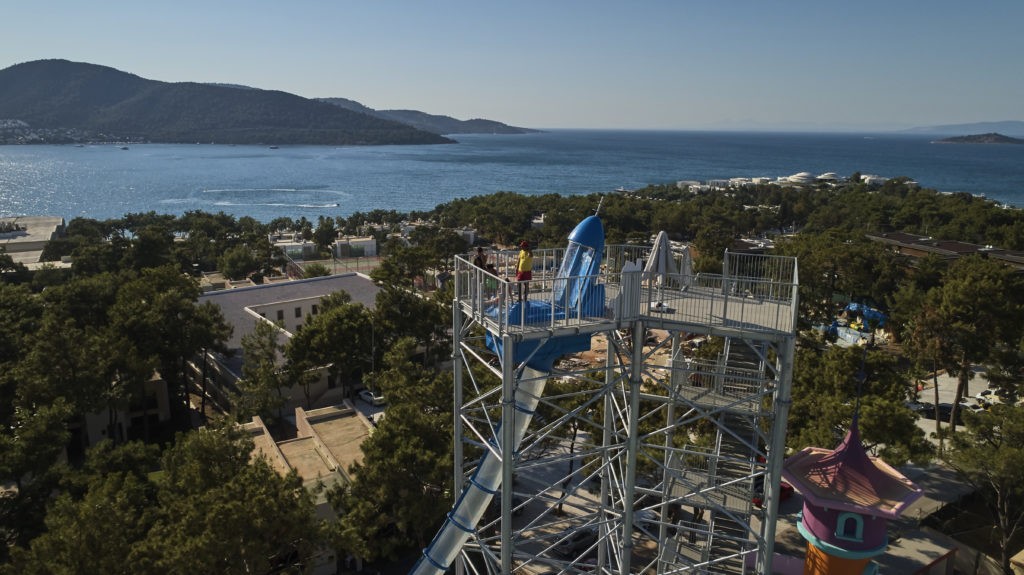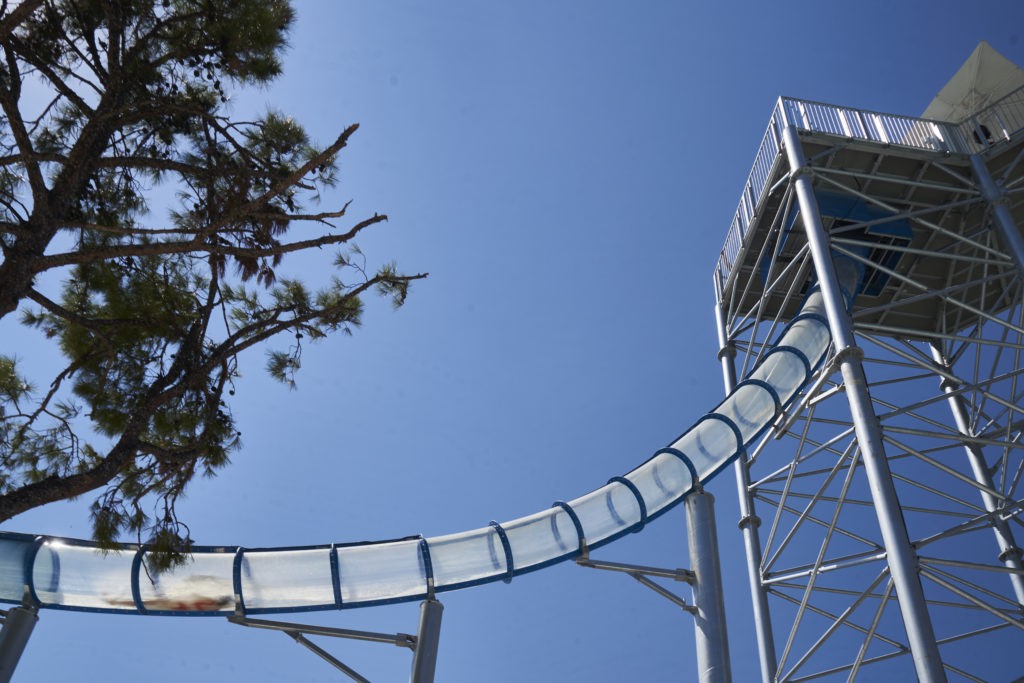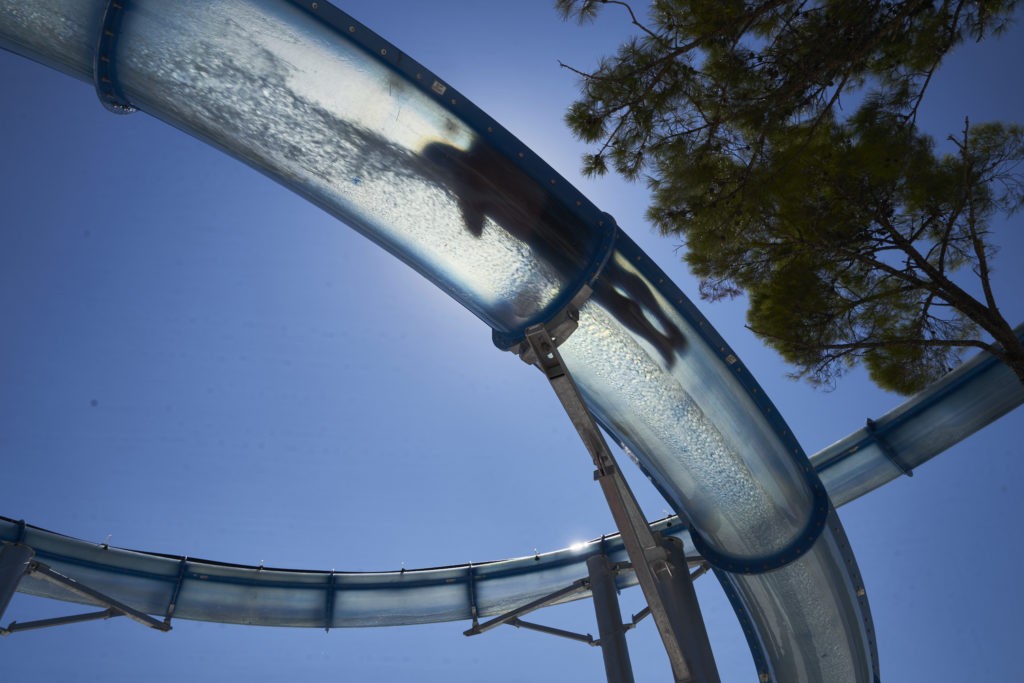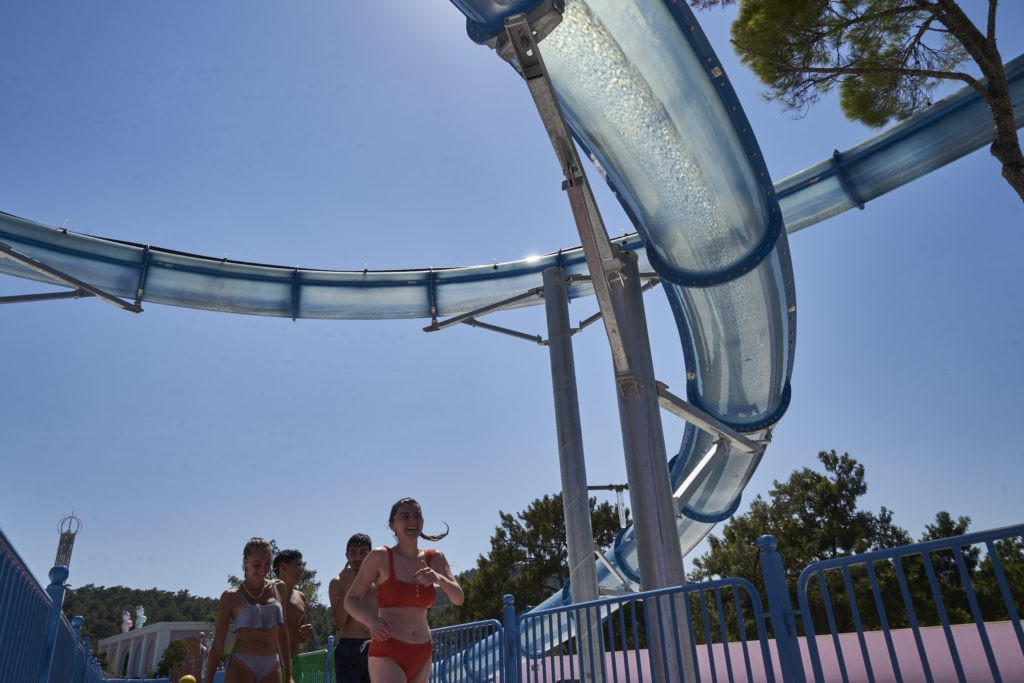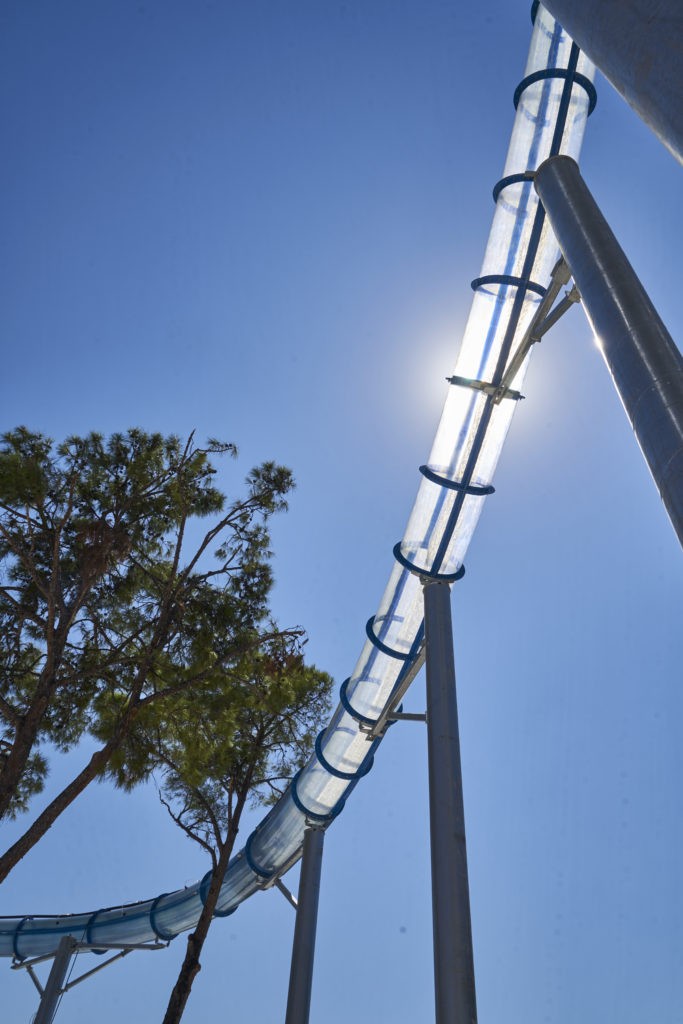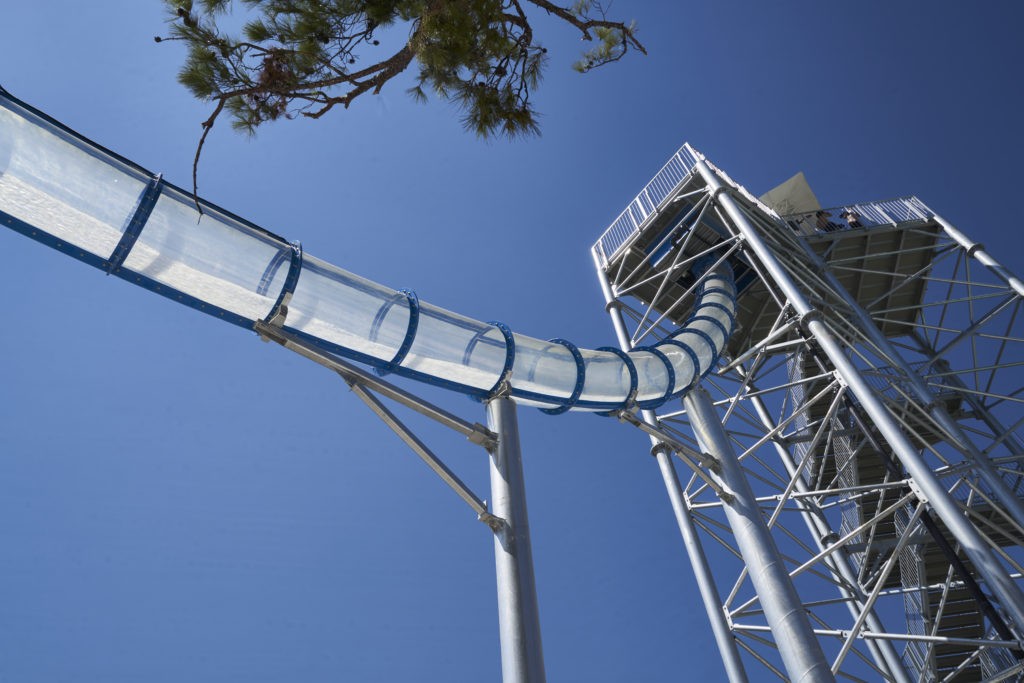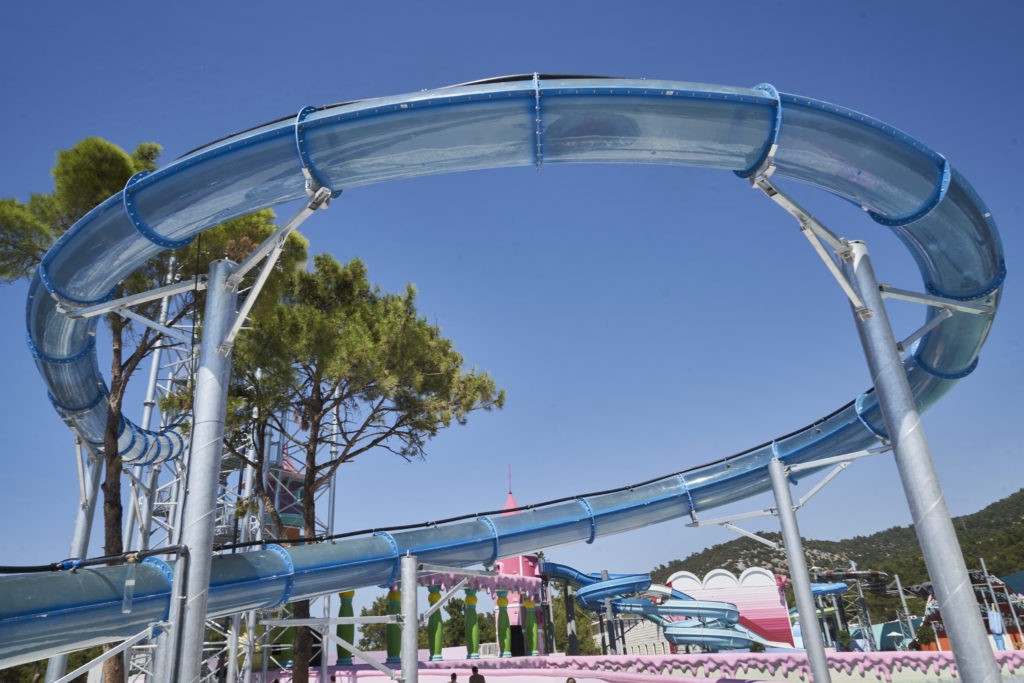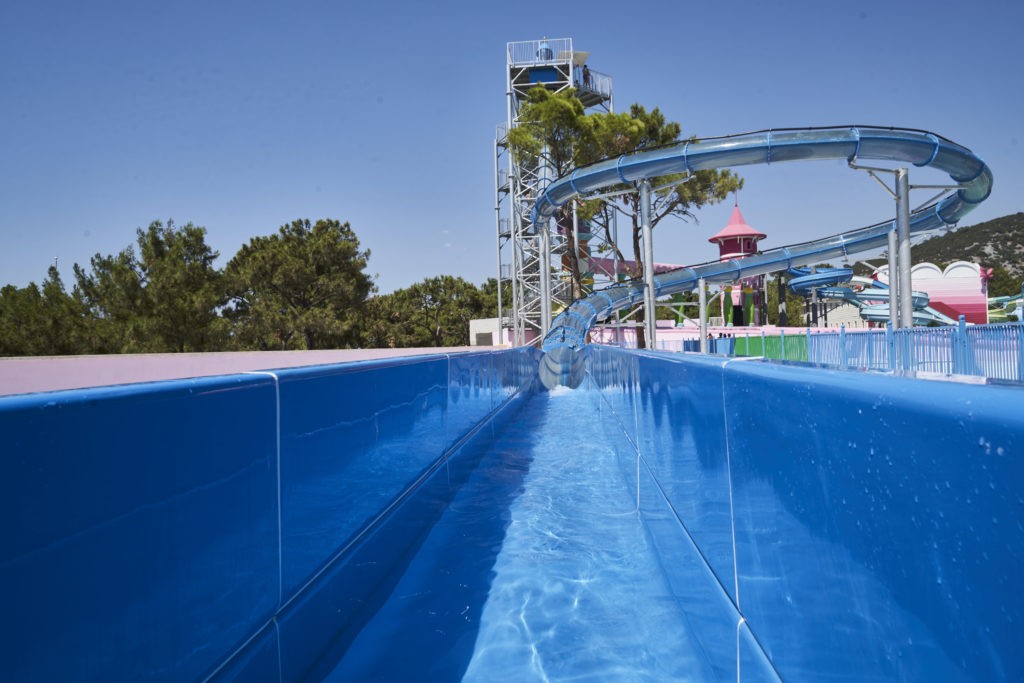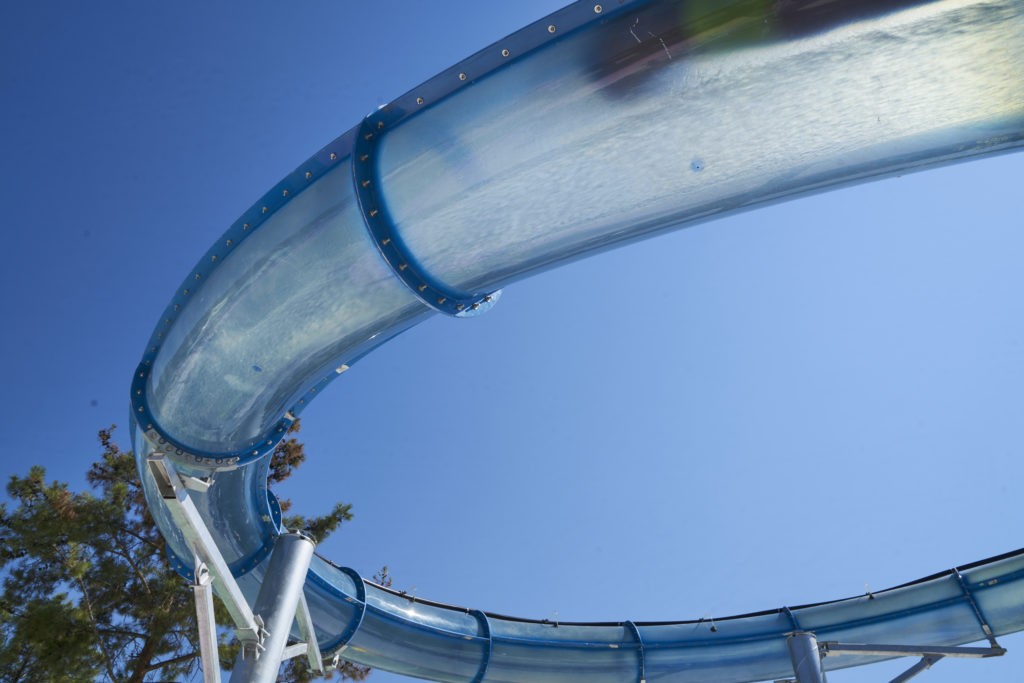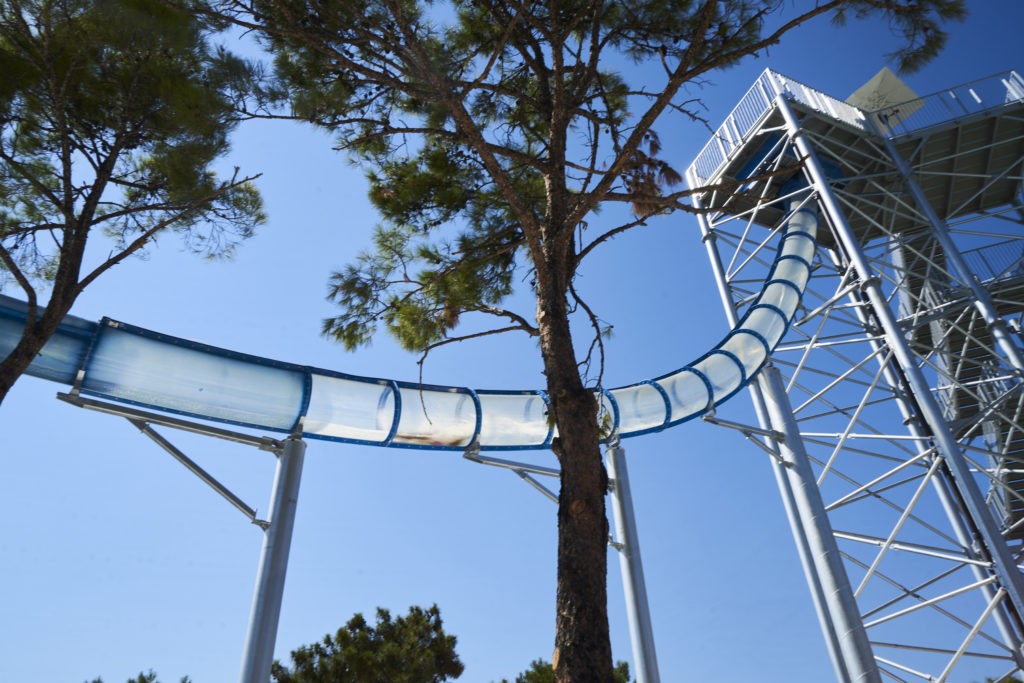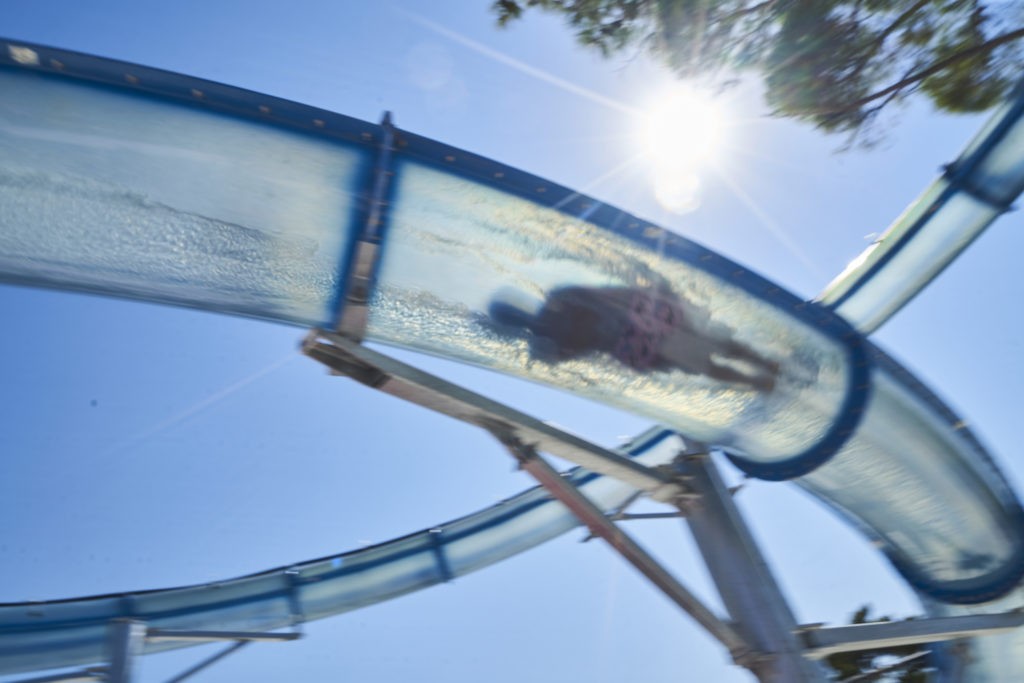Polin’s new Glassy product adds transparent charm to a resort’s new waterpark
by Joe Kleiman
ABOVE: Polin’s Looping Rocket, created with their clear composite Glassy, is now open at Candyland park at Vogue Hotel Bodrum. All photos courtesy of Polin.
On the shores of the Gulf of Gökova sits the city of Bodrum. The town is one of Turkey’s major tourist destinations, with its combination of historic sites, pristine beaches, and welcoming hospitality. Bodrum plays an important role in Turkey’s $40 billion tourism economy. According to the Bodrum Hotelier’s Association, foreign tourists flock to the city from throughout Europe, primarily from the UK, Germany, The Netherlands, Ukraine, Russia, and Poland. These foreign travelers supplement an already robust domestic tourism comprised of both overnight vacationers and day trippers, and help fill vacancies during off-peak times.
Candyland and the integrated resort model
Over the millennia, Bodrum has been the home of a number of significant landmarks. It was built upon the site of the Greek town of Halicarnassus, birthplace of the historian Herodotus, and home of the Tomb of King Mausolus (from which the term “mausoleum” is derived), one of the Seven Wonders of the Ancient World. In the 15th Century, Knights Hospitaller constructed the Castle of St. Peter at the water’s edge. The small town within the castle’s fortifications would grow to become the modern city of Bodrum.
Five kilometers outside Bodrum sits the village of Torba. Lush forests of pine and olive trees dot the hillsides, providing a breathtaking backdrop to Torba’s luxury beachside resorts. In 2020, one of these resorts, the Vogue Hotel Bodrum, opened an entertainment center called Candyland to expand its offerings to family guests.
With this expansion the Vogue Hotel Bodrum reflects a continuing and successful trend among hotel and attraction operators worldwide: the diversification of offerings that make properties into fully integrated resorts, catering to overnight guests as well as day visitors and even accommodating business groups and conferences. Whether from the standpoint of hospitality or entertainment, regular reinvestment and expansion helps keep guests coming back year after year and expands the property’s market potential and destination status.
Entertainment operators benefit by adding a second or even a third gated attraction, giving guests more activity options and encouraging them to turn a day visit into a multi-day affair, which leads to an increased need for on-premises lodging. Likewise, hospitality operators find that investing in a leisure option such as a high-quality waterpark or other leisure option enriches the guest experience and differentiates the resort from its competition while promoting longer stays and increased guest spending.
The Candyland complex features a small amusement park and 5D cinema, but its centerpiece is its waterpark, with 25 slides provided by Polin Waterparks. Among these are the award-winning King Cobra, and a new wonder of the waterpark industry – the world’s first fully transparent composite waterslide, the Looping Rocket. Called Glassy, Polin’s new transparent composite is the result of a two-year R&D effort. In 2018, the product was officially previewed at a number of industry trade shows, including the IAAPA Expo in Orlando.
Composite creativity
Founded in 1976 by architect Enver Pakiş the Polin Group is a leading innovator in developing and manufacturing composite materials. It began by serving the construction industry and in 1989, the company began manufacturing composites for the European waterpark sector.
Serving multiple business sectors fuels innovative thinking, and Polin is able to apply what it learns from one space to another. Innovations in the attractions industry often happen with a creative new use of materials and technologies that originated in other fields. By 2006, Polin had begun applying specialty techniques, such as light-resin transfer molding (LRTM), typically used in industries such as automotive, aviation, and spacecraft, to its pioneering R&D work in waterslides, to the benefit of its clients and the industry. The newly adapted procedure allowed for symmetrically perfect parts on slides that were lighter, yet stronger than their traditional composite counterparts. By the end of the year, the company had converted its entire waterslide manufacturing operation to LRTM.
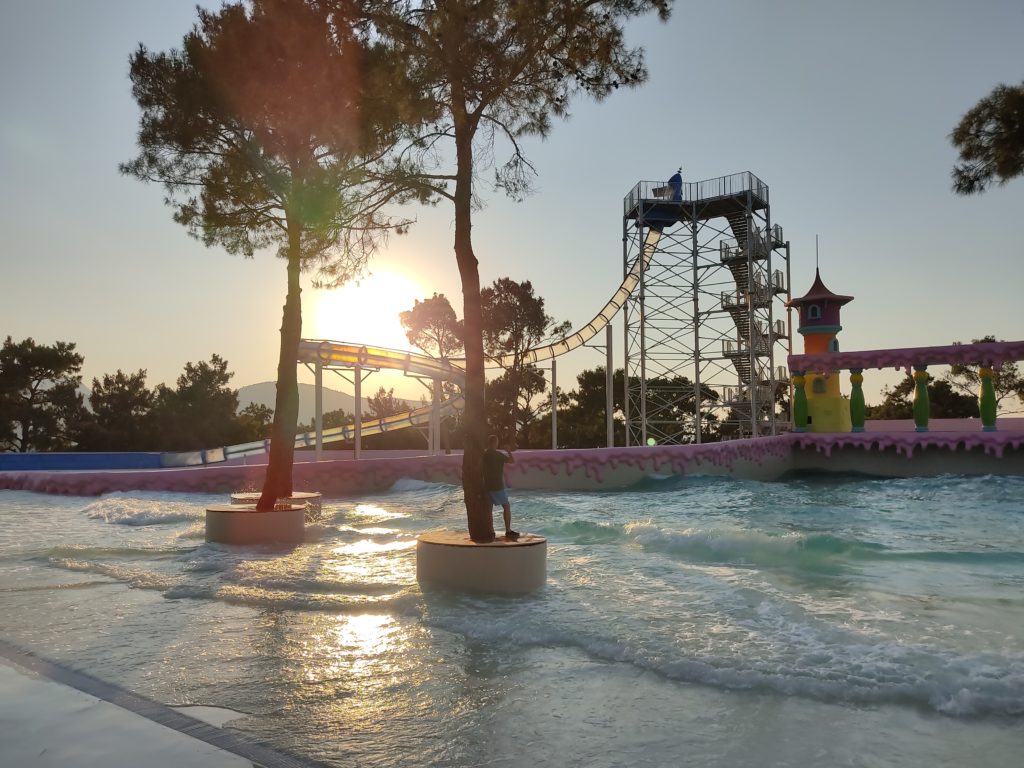
A key part of Polin’s success remains its research into new ways to manufacture composite materials. In 2018, Polin was designated as a Research & Development Centre by the Turkish government, affirming that the company’s R&D operations are consistent with government safety standards. More than fifty engineers are on staff developing new uses and construction methods for composites. Meanwhile, the company’s Polin Composites division remains one of the top manufacturers in Europe for aerospace, construction, automotive, hotels, transportation, wind energy, and, yes, waterslides.
The fiber of transparency
Some background and technological detail helps convey the significance of what Polin has achieved with Glassy, and why Ali Cansun, Director of R&D at Polin says, “Glassy will make a dynamic difference in the industry.”
Polin traditionally uses a process called Resin Transfer Molding (RTM) to create waterslides. Once molds are created for a slide piece, the shiny outer layer containing the slide’s color is sprayed onto the mold and dried. This is done to both the top and bottom molds. Next a sheet of white fiberglass fabric is placed on top of the mold. This fiberglass layer is what provides strength for the slide. The top and bottom molds are clamped together and filled with a resin composite. A vacuum pulls the liquid resin through the mold, which is then left to cure. Once finished, the molds are released and the slide piece is ready for finishing and assembly.
While this process is efficient, the slides it creates are opaque. For years, there have been two ways to manufacture see-through slides. The first and most common method involves colorful translucent composites, where the strength-to-thickness ratio in the manufacturing process allows for a semi-transparent portion of the slide. This allows light to shine through and illuminate the translucent composite but does not provide a fully clear slide. Sliders (people riding the slide) can see light coming through the slide and observers can see shadowy shapes moving through the slide, but not much more.
For fully transparent slides the industry has generally relied on acrylic tubes. However, unlike fiberglass, acrylic has a much lower fracture toughness. To compensate, acrylic parts are often thicker, resulting in a much heavier slide part. Because of this extra weight, additional cost and added maintenance, acrylic often is found in limited markets, such as where slides traverse an aquarium or aboard cruise ships. More often than not, these factors result in only partial use of acrylic in the overall slide construction.
Polin has developed a third solution to what it calls “the Holy Grail” of waterslides – completely transparent composites. The Glassy transparent material has a reflective index where the resin and the fiber of the composite are nearly the same. This allows the fiber to disappear from view. This “invisible” fiber gives an extra toughness to prevent fracture.
Another differentiating factor between acrylic and Glassy involves the connection between different ride segments. Acrylic slide parts do not have any connection flanges and therefore require special steel flanges and insulation materials during assembly. Glassy, on the other hand, uses its own connection flanges made from the same material as the Glassy slide. This results in a completely unobstructed view down the slide, inside and out.
From a maintenance standpoint, Glassy proves friendly to park operators. According to Polin, through the use of special additives and coatings, Glassy has a higher resistance to UVC and chlorine than the competition’s composite and acrylic products. Polin’s R&D division has also developed special repair techniques which will fix most damage to the Glassy slide in a short period of time.
Creative possibilities
These characteristicsopen up new possibilities for how Glassy can inspire new things in design – for waterslides and, we imagine, beyond waterslides – in ways that Polin’s internal teams and other industry creatives will discover and utilize in months and years to come. Dark rides? Haunted houses? Ride vehicles? Observation attractions? Immersive experiences?
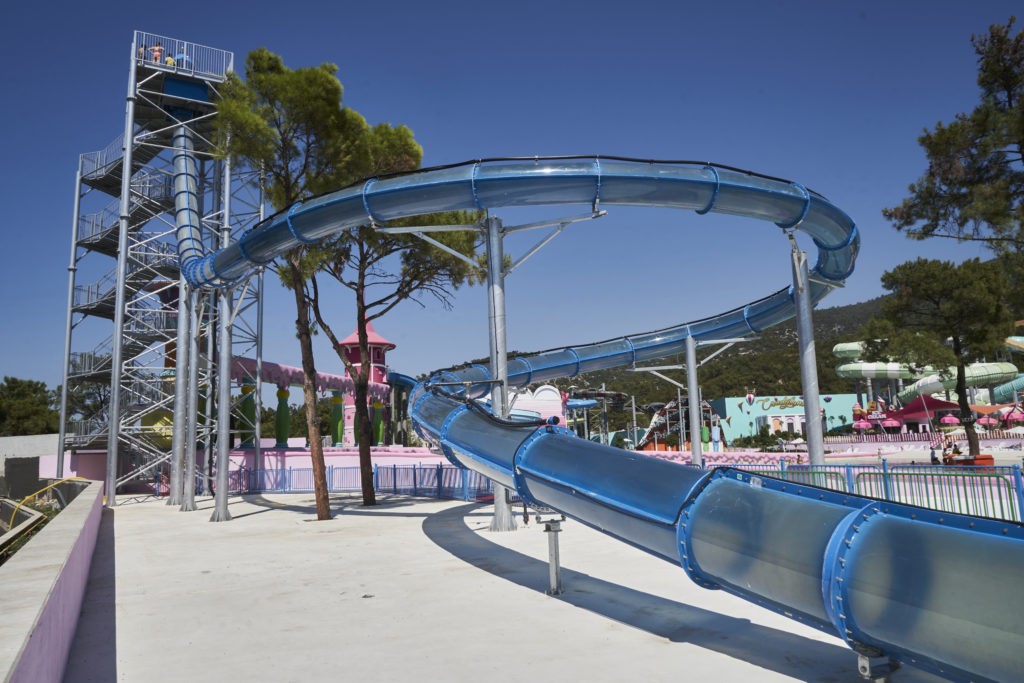
Polin is a company that has grown, adapted and diversified to succeed over nearly a half-century, from its beginnings as a manufacturer of composites for the construction industry to a pioneer and leader in the international attractions industry. In addition to designing and building rides, the company also offers wave pools and spray parks, and designs and operates aquariums and safari parks. For those who don’t have internal design teams, Polin has in-house creative facilities. Polin Design Studio works with clientele to suit their budget and location. Polin Attractions creates vehicle-based waterborne adventures. Through Polin Game Technologies, the company provides high tech water-based interactive gaming and VR waterslides.
As Sohret Pakis, Polin’s Director of Marketing and Communication, says, “Guests mostly want something to get their hearts pumping a bit, interactive experiences to share with one another, and fun themed attractions that make their day more interesting.”
We look forward to seeing how the industry and its creatives embrace Glassy. We know it’s going to be interesting.


